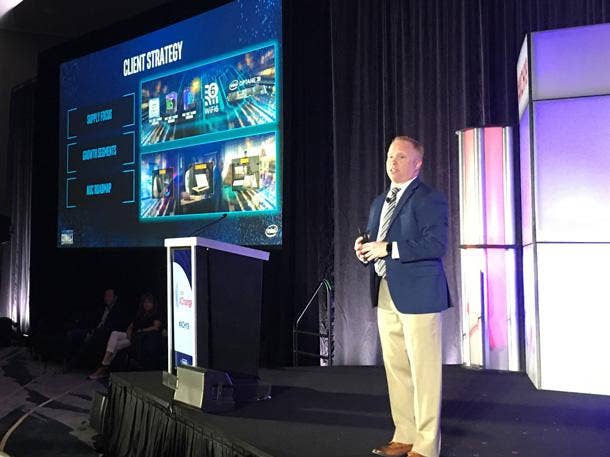Intel Counting On The Channel To Help Build Its Data-Centric Strategy
Intel is banking on partners to help it target an advanced data-centric total addressable market of $300 billion, with Todd Garrigues, Intel’s director of partner sales programs, telling solution providers ‘the growth we expect to come comes from you.’

Intel is continuing to build the server, client and storage technology it expects channel partners to use to advance its strategy of gaining share in the advanced IT industry.
That's the word from Todd Garrigues, Intel's director of partner sales programs, who Monday told solution provider attendees at this week's XChange 2019 conference in Denver that the company is looking for the channel to help it target a total addressable market for advanced data-centric technology worth $300 billion
"We dream up ways for industries to grow," Garrigues said.
[Related: The 10 Coolest Flash Storage And SSD Technologies Of 2019 (So Far)]
However, Garrigues said, Intel's strategy is to grow its $70 billion data-centric business without increasing the size of its sales force.
"What this means is the growth we expect to come comes from you. … We depend on you and our channel community," he said.
Intel's data-centic strategy is not new by any means, but it accelerated in 2013, Garrigues said. As a result, he said, the first half of 2019 saw nearly 50 percent of Intel's total revenue coming from its data-centric focus.
Intel's strategy has resulted in the company's development of multiple technologies Garrigues said makes it a platform company with an unparalleled ecosystem.
On the server side, Intel in April introduced its second-generation Xeon Scalable processor series, Garrigues said. Those processors, previously code-named Cascade Lake, offer a 30 percent performance boost over the previous generation. They also include built-in artificial intelligence technology, he said.
On the storage side, Intel launched its first SSDs 10 or 11 years ago, but has since grown beyond simple SSDs to introduce Intel Optane DC Persistent Memory, Garrigues said.
Intel said when Intel Optane DC Persistent Memory was introduced that its performance fit between high-performance SSDs and extremely low-latency DRAM, but without the DRAM disadvantage of losing memory if the power is lost.
On the client side, Intel is still seeing growth despite the constraints it faced in processor shipments caused in part by the growing market, Garrigues said.
Supply of some processor SKUs is still tight, according to Garrigues. "But we've made significant progress," he said.
Intel in October is planning to launch a new version of its NUC, or "Next Unit of Computing," micro PCs that are among the smallest PCs ever built and feature the Celeron processor and a fanless design. The NUC has no moving parts, comes with a three-year warranty, and is validated for 24x7 operation, he said.
Intel also knows that for it to succeed in its data-centric strategy, it needs partnerships, Garrigues said. To that end, the company in March announced its Intel Partner Alliance, replacing what is currently known as the Intel Technology Partner Program and other partner programs.
While the Intel Partner Alliance is scheduled to officially launch in mid-2020, Intel in October will launch the first part of the alliance, the Intel Partner University, under which the company will move all of its channel training into a single place and use artificial intelligence to make it easy for partners to find the right training, Garrigues said.
October will also see Intel launch the Intel Solutions Marketplace, a business-to-business online platform that will help partners collaborate and promote their solutions and products to end users, he said.
While Rick "MacGyver" Tashman, managing director of Tashman Tech Group, a Philadelphia-based solution provider specializing in the IT side of data center building, finds a lot to be interesting in Intel's data-centric strategy, the pending introduction of the new NUC is what really piqued his interest.
Tashman told CRN his nickname "MacGyver" comes from his ability to build certain components needed to make data centers work. For instance, he said, many of the components in the data center infrastructure such as cooling pumps can be 30 or more years old and need constant monitoring.
For instance, Tashman said, he is now building monitoring devices by converting a door switch, but sees the fanless design of the new NUC as a much better data center play.
"The NUC can be used in places like the data center where I can't put PCs," he said. "I got goosebumps when I saw Intel talk about the new NUCs."